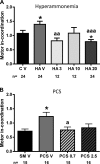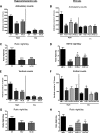GR3027 antagonizes GABAA receptor-potentiating neurosteroids and restores spatial learning and motor coordination in rats with chronic hyperammonemia and hepatic encephalopathy
- PMID: 26138462
- PMCID: PMC4556948
- DOI: 10.1152/ajpgi.00073.2015
GR3027 antagonizes GABAA receptor-potentiating neurosteroids and restores spatial learning and motor coordination in rats with chronic hyperammonemia and hepatic encephalopathy
Abstract
Hepatic encephalopathy (HE) is one of the primary complications of liver cirrhosis. Current treatments for HE, mainly directed to reduction of ammonia levels, are not effective enough because they cannot completely eliminate hyperammonemia and inflammation, which induce the neurological alterations. Studies in animal models show that overactivation of GABAA receptors is involved in cognitive and motor impairment in HE and that reducing this activation restores these functions. We have developed a new compound, GR3027, that selectively antagonizes the enhanced activation of GABAA receptors by neurosteroids such as allopregnanolone and 3α,21-dihydroxy-5α-pregnan-20-one (THDOC). This work aimed to assess whether GR3027 improves motor incoordination, spatial learning, and circadian rhythms of activity in rats with HE. GR3027 was administered subcutaneously to two main models of HE: rats with chronic hyperammonemia due to ammonia feeding and rats with portacaval shunts (PCS). Motor coordination was assessed in beam walking and spatial learning and memory in the Morris water maze and the radial maze. Circadian rhythms of ambulatory and vertical activity were also assessed. In both hyperammonemic and PCS rats, GR3027 restores motor coordination, spatial memory in the Morris water maze, and spatial learning in the radial maze. GR3027 also partially restores circadian rhythms of ambulatory and vertical activity in PCS rats. GR3027 is a novel approach to treatment of HE that would normalize neurological functions altered because of enhanced GABAergic tone, affording more complete normalization of cognitive and motor function than current treatments for HE.
Keywords: GABAA receptors; hepatic encephalopathy; hyperammonemia; neurosteroids.
Copyright © 2015 the American Physiological Society.
Figures







Similar articles
-
GABAA receptor modulating steroid antagonists (GAMSA) are functional in vivo.J Steroid Biochem Mol Biol. 2016 Jun;160:98-105. doi: 10.1016/j.jsbmb.2015.10.019. Epub 2015 Oct 30. J Steroid Biochem Mol Biol. 2016. PMID: 26523675 Review.
-
Golexanolone, a GABAA receptor modulating steroid antagonist, restores motor coordination and cognitive function in hyperammonemic rats by dual effects on peripheral inflammation and neuroinflammation.CNS Neurosci Ther. 2022 Nov;28(11):1861-1874. doi: 10.1111/cns.13926. Epub 2022 Jul 26. CNS Neurosci Ther. 2022. PMID: 35880480 Free PMC article.
-
Extra-Synaptic GABAA Receptor Potentiation and Neurosteroid-Induced Learning Deficits Are Inhibited by GR3027, a GABAA Modulating Steroid Antagonist.Biomolecules. 2023 Oct 9;13(10):1496. doi: 10.3390/biom13101496. Biomolecules. 2023. PMID: 37892178 Free PMC article.
-
Neuroinflammation increases GABAergic tone and impairs cognitive and motor function in hyperammonemia by increasing GAT-3 membrane expression. Reversal by sulforaphane by promoting M2 polarization of microglia.J Neuroinflammation. 2016 Apr 18;13(1):83. doi: 10.1186/s12974-016-0549-z. J Neuroinflammation. 2016. PMID: 27090509 Free PMC article.
-
Modulation of GABAA receptors by neurosteroids. A new concept to improve cognitive and motor alterations in hepatic encephalopathy.J Steroid Biochem Mol Biol. 2016 Jun;160:88-93. doi: 10.1016/j.jsbmb.2015.08.020. Epub 2015 Aug 22. J Steroid Biochem Mol Biol. 2016. PMID: 26307490 Review.
Cited by
-
The Mechanism of Hepatic Encephalopathy Induced by Thioacetamide Based on Metabolomics and Proteomics: A Preliminary Study.Int J Mol Sci. 2023 Dec 24;25(1):284. doi: 10.3390/ijms25010284. Int J Mol Sci. 2023. PMID: 38203455 Free PMC article.
-
Recent advances in hepatic encephalopathy.F1000Res. 2017 Sep 4;6:1637. doi: 10.12688/f1000research.11938.1. eCollection 2017. F1000Res. 2017. PMID: 29026534 Free PMC article. Review.
-
Role of peripheral inflammation in minimal hepatic encephalopathy.Metab Brain Dis. 2024 Dec;39(8):1667-1677. doi: 10.1007/s11011-024-01417-5. Epub 2024 Aug 23. Metab Brain Dis. 2024. PMID: 39177864 Review.
-
Bicuculline Reduces Neuroinflammation in Hippocampus and Improves Spatial Learning and Anxiety in Hyperammonemic Rats. Role of Glutamate Receptors.Front Pharmacol. 2019 Feb 25;10:132. doi: 10.3389/fphar.2019.00132. eCollection 2019. Front Pharmacol. 2019. PMID: 30858801 Free PMC article.
-
Effects of oxidative stress on hepatic encephalopathy pathogenesis in mice.Nat Commun. 2023 Jul 24;14(1):4456. doi: 10.1038/s41467-023-40081-8. Nat Commun. 2023. PMID: 37488119 Free PMC article.
References
-
- Ahabrach H, Piedrafita B, Ayad A, El Mlili N, Errami M, Felipo V, Llansola M. Chronic hyperammonemia alters the circadian rhythms of corticosteroid hormone levels and of motor activity in rats. J Neurosci Res 88: 1605–1614, 2010. - PubMed
-
- Ahboucha S, Coyne L, Hirakawa R, Butterworth RF, Halliwell RF. An interaction between benzodiazepines and neuroactive steroids at GABAA receptors in cultured hippocampal neurons. Neurochem Int 48: 703–707, 2006. - PubMed
-
- Ahboucha S, Pomier-Layrargues G, Mamer O, Butterworth RF. Increased levels of pregnenolone and its neuroactive metabolite allopregnanolone in autopsied brain tissue from cirrhotic patients who died in hepatic coma. Neurochem Int 49: 372–378, 2006. - PubMed
-
- Ahboucha S, Butterworth RF. The neurosteroid system: implication in the pathophysiology of hepatic encephalopathy. Neurochem Int 52: 575–587, 2008. - PubMed
-
- Ahboucha S, Jiang W, Chatauret N, Mamer O, Baker GB, Butterworth RF. Indomethacin improves locomotor deficit and reduces brain concentrations of neuroinhibitory steroids in rats following portacaval anastomosis. Neurogastroenterol Motil 20: 949–957, 2008. - PubMed
Publication types
MeSH terms
Substances
LinkOut - more resources
Full Text Sources
Other Literature Sources

